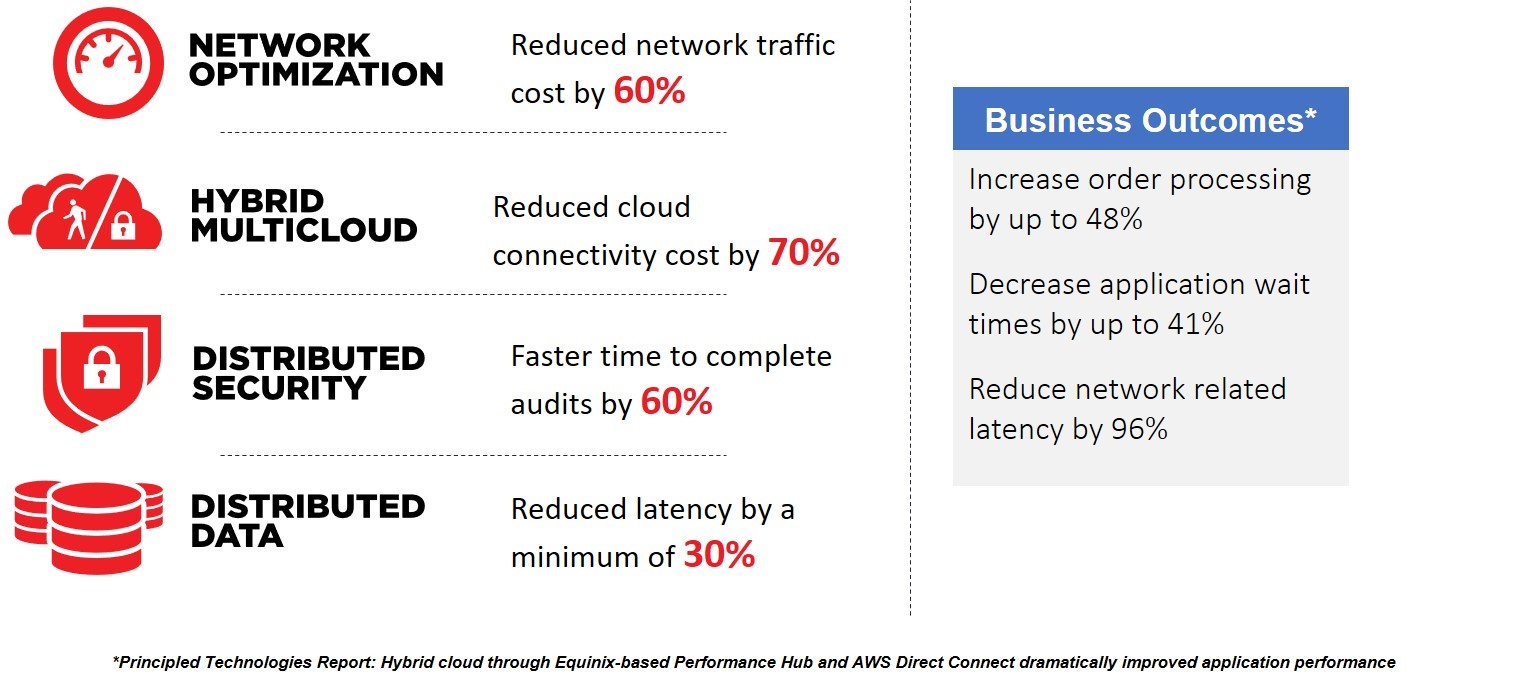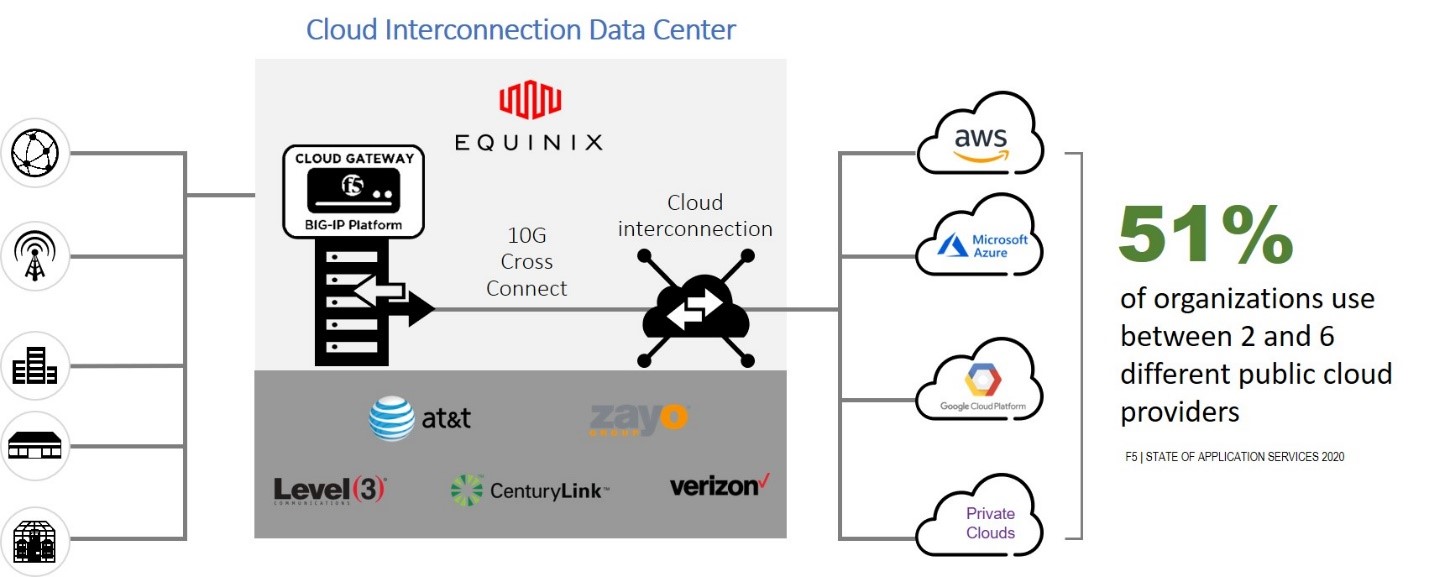Verbesserung der Geschäftsergebnisse und Anwendungserfahrungen mit einem Cloud-Gateway in Equinix
Basierend auf unseren Untersuchungen gehören Sie mit ziemlicher Sicherheit zu den 87 % der Unternehmen, die Anwendungen bei mehreren Cloud-Anbietern betreiben. Von dieser Mehrheit nutzen Sie höchstwahrscheinlich auch zwischen zwei und sechs verschiedene öffentliche Cloud-Anbieter. Bei mehr als der Hälfte (51 %) der Organisationen ist dies der Fall.
Die Art und Weise, wie diese Organisationen einen öffentlichen Cloud-Anbieter für die Bereitstellung einer Anwendung auswählen, ist unterschiedlich. Die gängigste Strategie basiert dabei ausschließlich auf der Anwendung selbst. Zu den Variationen gehört die Berücksichtigung des Benutzertyps (Verbraucher, Partner, Mitarbeiter) sowie des Anwendungstyps, z. B. Cloud-nativ, mobil oder Legacy.
Dies führt dazu, dass Organisationen Anwendungen in einem stark verteilten Modell betreiben. Einige Apps sind vor Ort, andere in AWS, wieder andere in Azure und GCP. Der Betrieb und die Verwaltung dieser Cloud-Eigenschaften werden jedoch zunehmend zentralisiert.
So ergab eine Studie von RightScale , dass 69 % der Unternehmen ein zentralisiertes Cloud-Teammodell eingeführt haben. Die Hauptverantwortung dieser zentralisierten Teams liegt in der Optimierung der Cloud-Kosten (68 %), der Entscheidung, welche Anwendungen in welcher Cloud bereitgestellt werden sollen (62 %) und nicht zuletzt in der Festlegung von Richtlinien für die Cloud-Nutzung (59 %).
Um die Optimierungsgleichung zu verbessern, muss man sich einmal genauer ansehen, was die Bereitstellung einer Anwendung in der öffentlichen Cloud wirklich bedeutet. Denn nicht nur die Anwendungen sind auf mehrere Cloud-Eigenschaften verteilt. Die Bereitstellung und Sicherung dieser Anwendungen ist die Aufgabe von Anwendungsdiensten, die Anwendungen in Erlebnisse verwandeln. Erfahrungen, die laut Verbraucherforschung erhebliche Auswirkungen auf alles haben, vom Ruf der Marke über die Kundenabwanderung bis hin zu tatsächlichen Geschäftsauswirkungen . Diese Anwendungsdienste werden zusammen mit den Anwendungen, die sie bereitstellen und sichern, verteilt, was die Komplexität erhöht.
Die Verteilung von Anwendungen und den sie unterstützenden Diensten auf mehrere Liegenschaften hat weitreichende Folgen. Von der Netzwerkkapazität bis zu inkonsistenten Sicherheitsrichtlinien, von schwankender Leistung bis zu einem Mangel an vollständiger Verkehrstransparenz – die Multi-Cloud-Realität bringt für jede Rolle innerhalb der Organisation Herausforderungen mit sich.
Die Lösung, die viele als Reaktion darauf wählen, besteht in der privaten Verbindung zu mehreren Clouds über Equinix. Als Peering-Punkt für jede große öffentliche Cloud bietet Equinix blitzschnelle Verbindungen mit extrem geringer Latenz zu den öffentlichen Clouds, die von den meisten Organisationen bereits über ihre virtuelle Verbindungslösung Equinix Cloud Exchange Fabric (ECXF) verwendet werden.
Equinix löst Probleme mit Konnektivität, Latenz und Kapazität auf den Netzwerkebenen mit seinen Cloud-Edge-Standorten und der Netzwerkmagie. Es löst Herausforderungen hinsichtlich der Konsistenz der Sicherheitsrichtlinien und der vollständigen Transparenz der Verkehrsflüsse, indem es gleichzeitig als Kontrollpunkt zwischen Benutzern, Standorten, Clouds und Daten fungiert, an dem Unternehmen die Vorteile und Funktionen eines Cloud-Gateways bereitstellen und nutzen können.
Das Cloud-Gateway
Ein Cloud-Gateway bietet einen einzigen, skalierbaren Standort, an dem Anwendungsanforderungen und Datenverkehr, die ein „Anwendungserlebnis“ ausmachen, abgefangen, geprüft und an das beabsichtigte Ziel weitergeleitet werden können – und das alles von einem einzigen, vernetzten Kontrollpunkt aus.
In der Rolle eines Cloud-Gateways bietet F5 BIG-IP die Anwendungsdienste, die Organisationen benötigen, um konsistente Sicherheits-/Zugriffsrichtlinien bereitzustellen, Anwendungsschutzmaßnahmen einzusetzen und vollständige Transparenz hinsichtlich Verkehrsflüssen und Anwendungsnutzung zu gewährleisten. Es kann die Cloud-Kosten senken, indem es verhindert, dass unerwünschter Datenverkehr (böswillige Akteure, Bots, Angriffe) Anwendungen erreicht, die bei einem öffentlichen Cloud-Anbieter gehostet werden. Die Sicherheit lässt sich durch den Einsatz von Equinix SmartKey TM , einer zentralisierten Schlüsselverwaltungslösung zur Sicherung des Datenverkehrs, verbessern und so die riskante Praxis der Speicherung von Verschlüsselungsschlüsseln in einer öffentlichen Cloud vermeiden.
Der Einsatz eines Cloud-Gateways in der Equinix-Umgebung bietet zahlreiche Vorteile; zu viele, um sie in einem Beitrag zu erläutern. Aus diesem Grund werden wir in den folgenden Beiträgen detaillierter darauf eingehen und uns dabei jeweils auf eine andere Funktion – und die Vorteile – eines Cloud-Gateways konzentrieren.
Wenn Sie nicht warten möchten und sofort loslegen wollen, finden Sie hier einige hilfreiche Materialien, die Sie näher informieren:
- Equinix Technologie-Allianz
- Equinix und F5: Übernehmen Sie die Kontrolle über Ihre Hybrid Cloud-Sicherheit
Passen Sie auf sich auf und bleiben Sie dran für weitere Informationen!


